|
Morus capensis (Cape Gannet)
Witmalgas [Afrikaans]; Umkholonjane [Xhosa]; Kaapse
jan-van-gent, [Dutch]; Fou du Cap [French]; Kaptölpel [German]; Alcatraz do
Cabo [Portuguese]
Life
> Eukaryotes >
Opisthokonta
> Metazoa (animals) >
Bilateria >
Deuterostomia > Chordata >
Craniata > Vertebrata (vertebrates) > Gnathostomata (jawed
vertebrates) > Teleostomi (teleost fish) > Osteichthyes (bony fish) > Class:
Sarcopterygii (lobe-finned
fish) > Stegocephalia (terrestrial
vertebrates) > Tetrapoda
(four-legged vertebrates) > Reptiliomorpha > Amniota >
Reptilia (reptiles) >
Romeriida > Diapsida > Archosauromorpha > Archosauria >
Dinosauria
(dinosaurs) > Saurischia > Theropoda (bipedal predatory dinosaurs) >
Coelurosauria > Maniraptora > Aves
(birds) > Order: Ciconiiformes >
Family: Sulidae
Distribution and habitat
It breeds on islands along the coast of southern Africa, on
Ichaboe and Possession Island (Namibia); Bird Island in Lambert's Bay and Malgas
Island (Western Cape); Bird Island in Algoa Bay (Eastern Cape). In the
non-breeding season, it disperses across the entire coast of southern Africa and
northern Mozambique, also heading up the west Coast all the way to Ghana and
Nigeria. It generally sticks fairly close to the coastline, while favouring
islands with flat or sloping ground for nesting.
|
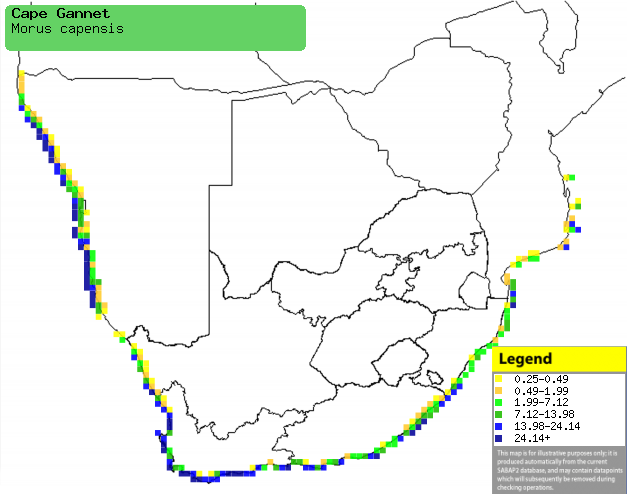 |
|
Distribution of Cape gannet in southern Africa,
based on statistical smoothing of the records from first SA Bird Atlas
Project (©
Animal Demography unit, University of
Cape Town; smoothing by Birgit Erni and Francesca Little). Colours range
from dark blue (most common) through to yellow (least common).
See here for the latest distribution
from the SABAP2. |
Predators and parasites
- Predators
- Parasites
- Pasteurella multocida (Avian cholera)
- Aspergillosus fumigatus (Saprophytic mould)
- mites
Movements and migrations
Adults usually remain within 540 km of the
island of their colony in winter, although they may travel up to
3300 km north. Immature birds move more freely however, following
sardine shoals up to KwaZulu-Natal or alternatively heading north to
West Africa, travelling up to about 6800 km: they even reach western
Australia on occasion.
Food
It mainly eats fish, doing most of its foraging in large
flocks of up to about 1000 birds, searching for shoals of fish from the air.
Once it locates prey it dives straight into the water, remaining submerged for
3-7 seconds, in which time it can descend up to 8 metres underwater using just
momentum. It often associates with other seabirds, such as
Cape cormorants,
Kelp gulls and
Sooty shearwaters, as well
as
dolphins, Cape fur seals (Arctocephalus
pusillus) and gamefish. The following food items have been recorded
in its diet:
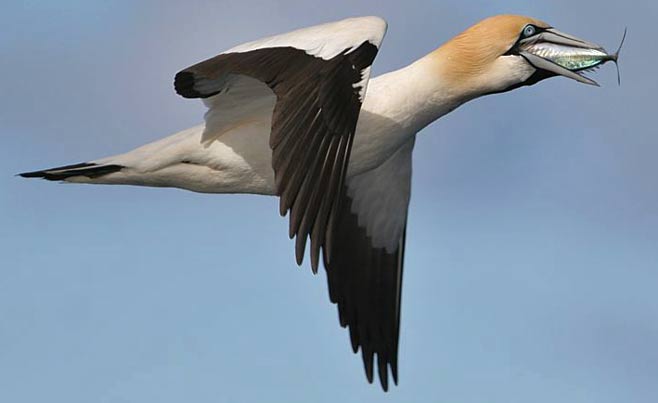 |
|
Cape gannet. with caught fish, pelagic trip off of
Cape Town, South Africa [photo Trevor Hardaker ©] |
- Fish
- Engraulis encrasicolus (Anchovy)
- Sufflogobius bibarbatus (Pelagic goby)
- Scomberesox saurus (Saury)
- Merluccius (hakes)
- Thyrsites atun (Snoek)
- Trachurus trachurus (Horse mackerel)
- Scomber japonicus (Chub mackerel)
- Sardinops sagax (Sardine)
- Etrumeus whiteheadi (Round herring)
- Cephalopods
- Loligo vulgaris (Chokka squid)
Breeding
- Monogamous colonial nester, living in large and tightly packed colonies of
up to about 68000 individuals. The sky-pointing display (seen in fig.1) is
used as a greeting; if an individual tries to manoeuvre through the colony
without holding its bill in the air, it is repeatedly pecked by other birds.
- The nest (see fig. 2) is a mound with a depression in the centre, made
of guano and other material, which is applied to the structure by vibrating
its mandible along the rim.
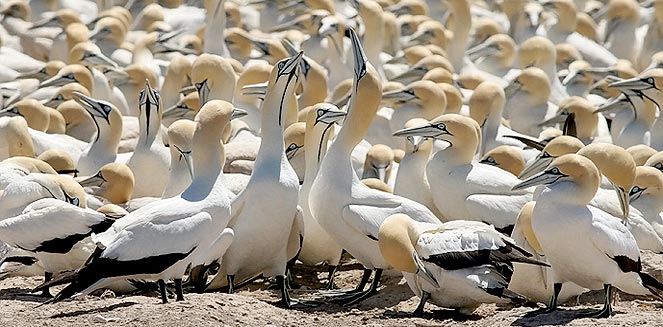 |
|
fig. 1 - Cape gannet colony, with two birds
greeting each other with the sky-pointing display. [photo
Jeff Poklen
©] |
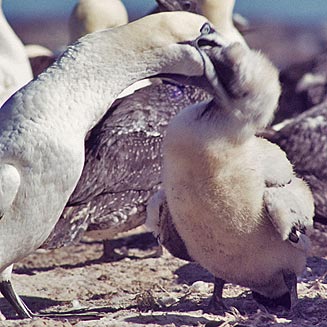 |
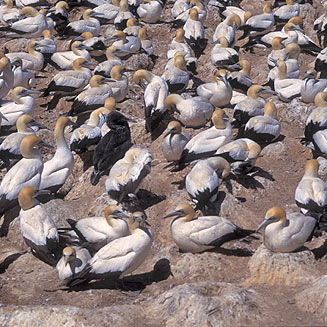 |
|
fig. 2 - Cape gannet, regurgitating food to chick. [photo
H. Robertson ©] |
fig. 3 -
Cape gannets on their nests. [photo Peter Steyn
©] |
- Egg-laying season can be year-round, peaking from September-April.
- It lays a single egg, rarely two, which is incubated by both sexes for
about 43-44 days.
- The chick is fed by both sexes by regurgitation (see fig. 2) and brooded
for the first 2-3 days of its life. It leaves the nest at 90-105 days old,
remaining on the colony edge for another six days or so before dispersing
completely.
Threats
Vulnerable, as its population has decreased by at
least 20% in three generations, and is especially in trouble in Namibia. This is
largely due to the collapse of Sardine (Sardinops sagax) and other fish
stock, as well as occasional oil spills which cause hundreds of deaths.
References
-
Hockey PAR, Dean WRJ and Ryan PG 2005. Roberts
- Birds of southern Africa, VIIth ed. The Trustees of the John Voelcker
Bird Book Fund, Cape Town.
-
Harrison, J.A., Allan, D.G., Underhill, L.G., Herremans, M.,
Tree. A.J., Parker, V. & Brown, C.J. (eds). 1997. The atlas of southern
African birds. Vol. 2: Passerines. BirdLife South Africa, Johannesburg.
|
